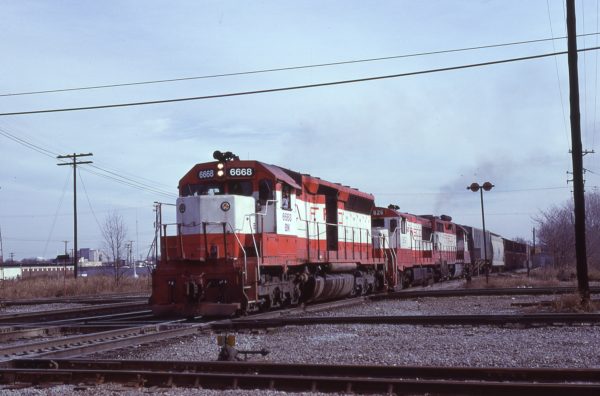SW9s 265 (Frisco 310) and 267 (Frisco 312)

SW9s 265 (Frisco 310) and 267 (Frisco 312) at St. Louis, Missouri on September 9, 1981 (M.A. Wise).

SW9s 265 (Frisco 310) and 267 (Frisco 312) at St. Louis, Missouri on September 9, 1981 (M.A. Wise).

SD45 6668 (Frisco 919) and U25B 826 at Memphis, Tennessee in December 1980.
The train is northbound on the Memphis Subdivision. It has just passed the manual interlocking stop sign signal at the Illinois Central Gulf (ICG) diamond crossing at mile post 483.8 (MP 483.8). This is just South (0.6 miles) of Memphis Central Station (MP 484.4).
At this point of its trip, the train is on “Broadway”. “Broadway” is a corridor of multiple railroad’s tracks south of the city’s downtown extending west to east from the Mississippi River bridges to KC Junction. Earlier the train departed Frisco’s Tennessee Yard hump complex at (MP 496.4). This yard is 12.6 miles South (railroad) from this location on the southeast side of the city, just North of the state line with Mississippi.
After stopping the train is accelerating as it continues its northward journey. Soon it will enter an elongated S-curve, passing the North end of the Frisco’s two main tracks at Shelco (Shelby County) at MP483.1. Just beyond Shelco it will go through the Frisco Bridge and cross the Mississippi River into Arkansas.
Note the signal with two elevated stop signs, which governs northward movements on the Frisco’s two main tracks at this location. A similar signal for southbound traffic is behind the photographer. When facing the signals (stop signs) there is a small round bracket signal to the right (on the left in this rear view).
The Frisco’s Rules of the Transportation Department, effective March 1, 1957, Rule 280 includes the paragraph, “When a track intervenes between a signal and track governed, a blue light on a bracket will be located to the right of the signal.” This indicates the second sign governs the second track, to the engineer’s right in this view.
Over the decades there have been at least 3 types of signal configurations at this location. In the early diesel era a locally controlled four sided street traffic light-style signal was located at this crossing. The signals in this view replaced the former in the early 1970s.
In mid-2005 construction started to remotely control this interlocking. New aluminum alloy bridges, cantilevers and vertical masts were erected for the various routes and connecting tracks. Replacement three-light, long hood type signals were installed. The new automated interlocking was activated the week of July 10, 2006.
The view is looking Northeast.
Special thanks to Mark Davidson.

GP38-2s 2365 (Frisco 695) and 2314 (Frisco 459) (date unknown) at Carthage, Missouri.

GP40-2s 3050 (Frisco 760), 3041 (Frisco 751) and 3056 (Frisco 766) at Tulsa, Oklahoma on August 5, 1982.